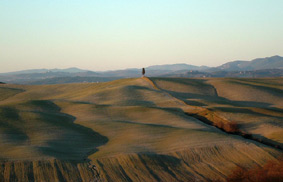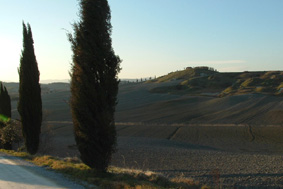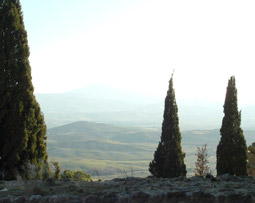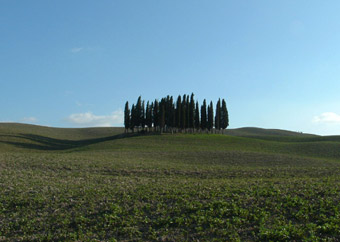|
|
Slow Tuscany
> Tuscany
> Livorno
> The Cypress and its role in the history of Tuscan art
The
Cypress: role of nature in the Tuscan history of Art (part
1)
Damiano
Andreini
|
|
|
For
several time I've been thinking of dedicating one or more articles
to the Tuscan history of art, especially underlining the elements
which better identify the image and the character of our land.
Therefore I run through concerned images, firstly by heart and
later searching in the books, but the huge artistic heritage
of our region offers so many subjects, over which we could talk
so long, that - once more - I decided to postpone it.
Suddenly, I realized that, instead, I could have thought of
something which was obvious to think of, since it consists of
a constant leitmotiv between the frescos and the paintings for
more of a thousand years in the Tuscan art and which ties them
up like the pearls of a necklace: it is not a stylistic element,
even though the stylistic effect of many works of art would
fail without this; it is not an iconographical detail, though
the meaning of the picture would be plain without this.

I am talking about a tree, more exactly I am talking about the
symbolic tree of our region: the Cypress. First of all, it has
to be said that the origins of the Cypress are not Italian but
its cradle is the eastern Mediterranean basin, ideally located
amongst Persia (the present Iran) Egypt and Greece, in fact
it grows there spontaneously. It was imported in Italy by Phoenicians
and Greeks and in Tuscany it was surely introduced by Etruscans.
The Cypress, further than decorating streets and gardens of
the Tuscan hills, for about 3,000 years, has continuously had
a symbolic and ornamental importance. Slim and slender cypresses
were regularly found in the gardens of marvellous Persian palaces.
In Athens, the intrinsic, solemn stylishness of the cypress
was particularly underlined, too. Egyptians exalted the noble
fiber of this three using only cypress wood to build sarcophagi
for the burial of the deceased.
Etruscans and Romans, too, gave to the cypress a symbolic meaning
connected to the mortuary context. In fact, they usually planted
cypress-trees all around cemeteries and tombs of famous characters
- thereby underlining their persuasion that the resin of the
cypress could cover the smell of dead people. Soon, the cypress
got more and more a funereal image. The craftsmen, instead,
ignore its funereal image and used its wood, whose fiber was
thick, regular and compact and therefore its good quality was
practically ideal to resist to time and inclemency of the weather,
to build everything, from the hulls of the ships to the doors
of villas and palaces, from the luxurious furniture to the most
refined musical instruments.

And also: according to the Bible the Noah's ark was made of
cypress wood and even the Christ's Cross was made of cypress,
together with pine and cedar woods. Therefore, even in a Judaic
context first and in a Christian one later on, the Cypress was
considered a symbol of Eternity, as well the Cedar-tree. During
the Middle Ages, the cypress accompanied the establishment and
the life of every convent and monastery: cypresses were used
as windbreak, as delimitation of the sacred from the lay space
and they also had a symbolical function: as well as per the
biblical tradition, according to which the tree of life is in
the center of the Celestial Jerusalem, the monks would plant
a Cypress or a Cedar-tree in the centre of their cloister, in
order to remind of the image of the Eternal City, whose brightness
is "equal to a gem of crystalline jasper".
Since over a thousand years the cypress is the indivisible companion
of each church, parish or convent all along the Tuscan countryside.
It represents the immortality (the cypress is an evergreen tree
and its wood, resistant for centuries, is often remembered in
the biblical tradition), the detachment from the "world" and
it also works as windbreak barrier around the sacred buildings,
which were often built top of the hills and therefore exposed
to the strong wind.

Starting from XIV century - at a time in which Dante Alighieri
was expelled from Florence and composed its Divine Comedy and
in which Giotto was in Assisi and fully revolutionized the concept
of figurative art - the cypress appeared in the luxuriant gardens
of the out-of-the-city villas of noble and bourgeois Florentines,
who already wished to reach the classical ideal of idyllic life
- under suggestion of humanists like Boccaccio and Petrarca
- to be parsimoniously consumed in a prosperous and verdant
environment.
It is here, among the smooth Tuscan hills and the works of art
realized by those learned and wealthy Maecenas of the Renaissance,
that the cypress plays a fundamental role as a real or ideal
frame of their dreams and ambitions. Next time we will talk
more deeply about this subject, which obviously deserves a further
space than that here practically left ...
Damiano Andreini |
|
|
